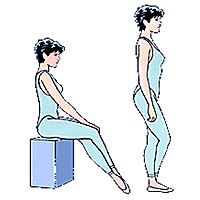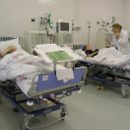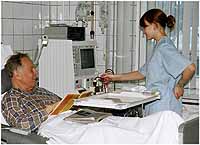The problem of urine incontinence in adults is very relevant, however, despite difficulty, it is almost always possible to find an acceptable solution. Non-drug treatment methods include carrying out the bladder training and execution of protection for pelvic muscles.
Content
Methods of non-drug treatment of urinary incontinence
In people who have never faced urine incontinence may appear - what we can talk about, and so everything is clear. However, for the patients themselves, this problem seems so difficult that it seems practically intractable. On the one hand, urinary incontinence is in fact not a simple problem, and on the other - it is almost always possible to find an acceptable solution for each patient.
Urinary incontinence affects almost all sides of the life of patients, significantly worsening their social, domestic, professional and family adaptation, that is, what is accepted by the term «the quality of life».
To the non-drug treatment of urine incontinence includes the conducting of the bladder training, performing exercises for pelvic muscles.
Urinary bubble training
The method of training the bladder includes three main components - training, creating a plan of urinals and its implementation.
The main sense of training consists in compliance with the patient in advance established and coordinated with the doctor's impact plan, that is, the patient should urinate at certain time intervals. In patients for several years of the disease, a peculiar stereotype of urination is formed, consisting in the desire to empty the bladder in case of even a minor urge. This desire is due to fear before the possible absence of urine, which can occur in an unsuitable environment.
The program of training the bladder is aimed at the progressive increase in the interval between urine. At the same time, the patient should try to urinate not when the urination appears on urination, and in accordance with his individual plan for the day. For this, patients must restrain the emerging urination at urination through strong reduction in the anal sphincter.
Treatment under the bladder training program usually lasts several months. It is recommended to raise the interval between urine for half an hour every 2-3 weeks until the time reaches 3-3.5 hours.
Water bubble training is most often carried out in combination with drug treatment. By the end time of the course of drug therapy, usually ongoing 3 months, a new psychological stereotype of urine should be formed. The cessation of drug intake as a result should not lead to the resumption of urination and urinary incontinence.
 History of use of exercises for the muscles of the pelvic bottom for the treatment of incontinence of urine has a long history. For the first time, the scientific substantiation of this method was given in 1948 a well-known American doctor-gynecologist Arnold Kegel. After his work, the exercises for pelvic muscles were widespread in the treatment of urinary incontinence, and such exercises themselves began to sometimes be called the treatment on Kegel.
History of use of exercises for the muscles of the pelvic bottom for the treatment of incontinence of urine has a long history. For the first time, the scientific substantiation of this method was given in 1948 a well-known American doctor-gynecologist Arnold Kegel. After his work, the exercises for pelvic muscles were widespread in the treatment of urinary incontinence, and such exercises themselves began to sometimes be called the treatment on Kegel.
The earlier treatment be started, the better the results will be achieved. In recent years, exercises for pelvic muscles are widely used in order to prevent urine incontinence, even before the very emergence of the first symptoms.
Women must learn to gearly cut the muscles of the perineum, compressive vagina and raising the rear pass for 15-20 seconds. It is necessary to try to learn how to reduce the muscles of the outdoor urethral sphincter, for example, trying to interrupt urine stream during conventional urination.
Subsequently, it is necessary to ensure that the muscles of the pelvic bottom are reflexively reduced with any increase in intra-abdominal pressure, for example, when coughing, any physical exertion and so on.
During the day, patients need to conduct 5 exercise sessions for pelvic muscles. For each session, you must perform at least 15-20 reductions of each type - slow and fast. We recommend alternating these cuts, that is, to perform them in turn during one session. After the tonic reduction within 1-5 seconds and a short period of rest (up to 5 seconds), a strong rapid short-term reduction is made, after which the rest time can be increased to 10 seconds. Thus, the number of similar cycles for one session should be about 15-20.
Start exercises best in the sitting position. The main value to achieve positive results of treatment is the regularity of training, without any breaks. Usually a month after the start of classes in the exercises can be performed in the standing position, and then when walking.
The first results of treatment, provided that the exercises and the correctness of their execution are regularly executed, 2-3 weeks after it began. The most frequent initial positive changes are the disappearance of urine leakage with small exercise, especially in the first half of the day.
The duration of treatment of patients according to this technique can not be predetermined in advance. Training must be carried out until urine incontinence, but also forms the ability of pelvic muscles to the reflex reduction in response to an increase in intra-abdominal pressure.
The urinary incontinence must be treated in the same way as any other diseases. It has nothing reprehensible or shame. Its reasons are known deviations in the structure and functions of some organism systems that can effectively eliminate various methods of treatment.









